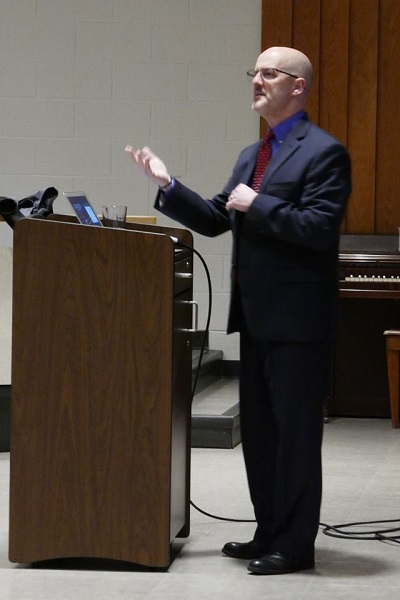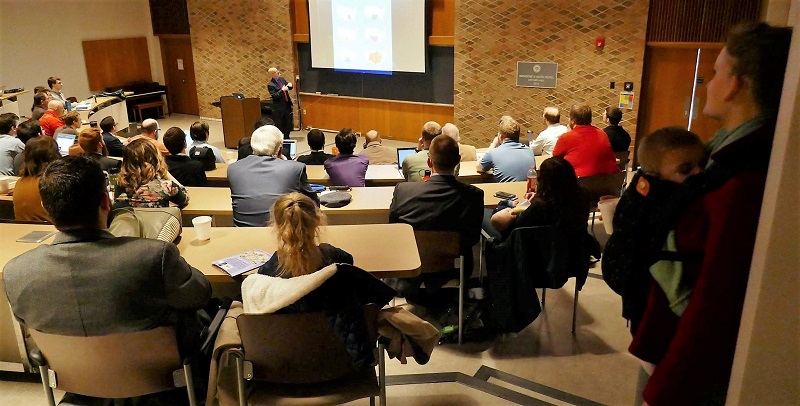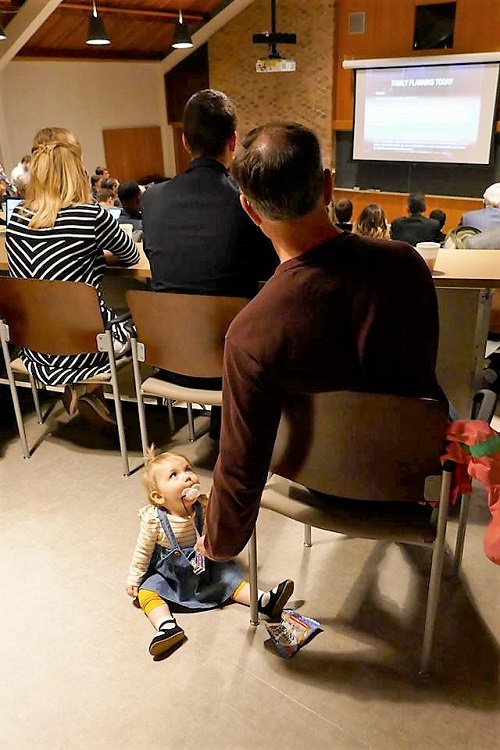
Yesterday’s convocation was once again hosted and organized by the CTSFW Life Team, who invited Dr. Christopher Stroud, a board certified Obstetrician-Gynecologist, to speak on the topic of contraception in view of pro-life values. Dr. Stroud and his wife, a certified nurse midwife, began the Fertility & Midwifery Care Center here in Fort Wayne so that they could uphold their values in a pro-life practice, utilizing Creighton Fertility Model/NaProTEHCNOLOGY (TM), which means they do not prescribe artificial contraceptives, place IUD’s, perform sterilization procedures, refer for IVF, or refer or participate in abortions. Since the pro-life goal is to protect the unborn and both recognize and respect human life from conception to natural death, his intention was to explore whether contraception is linked with abortion, specifically from a scientific viewpoint.
In his talk, he spoke on the science behind menstruation and the way that artificial contraceptives and IUD’s work. “This is not a Catholic talk,” Dr. Stroud began, who is himself a Catholic. “I’m not going to talk theology. I’m going to talk biology and maybe a little bit of sociology.” His intention was to equip our future pastors and deaconesses (and their spouses, many of whom were in attendance) to talk about it with the people they will someday serve.
To understand artificial contraceptives, you must understand the science behind the menstrual cycle. In as short a summary as possible:
The follicle stimulating hormone (FSH) signals follicle development in a woman, preparing the egg for ovulation (when the egg drops into the fallopian tube where sperm may be waiting). As the follicle containing the egg develops it produces estrogen, which in turns signals the lining of the uterus to thicken in preparation for possible implantation of an embryo. It also spurs on fertile cervical mucus, which allows the sperm to travel far enough up into the fallopian tube to reach the egg when it is released.
When enough estrogen has been produced, a surge of luteinizing hormone signals ovulation; the ruptured follicle left behind when the egg drops is now known as the corpus luteum and produces progesterone to stabilize the lining of the uterus for the next 14 days in preparation for a possible pregnancy, should sperm reach the egg. Fertilization happens in the distal part of the fallopian tube; the embryo is a genetically distinct human being before it travels the full length of the tube and implants in the hormonally-prepped and waiting uterine wall.
Artificial contraception works through a three-branched method:
1. A negative feedback loop. The contraceptive floods the woman’s system with estrogen in order to trick the body into thinking she’s already pregnant and thus shouldn’t release FSH to begin the process of ovulation; the egg never drops.
2. It dries up the cervical mucus, so that sperm can’t travel up the fallopian tube; fertilization can’t happen if sperm and egg never meet.
3. It makes the lining of the uterus so thin and atrophied that the embryo can’t implant. The life already created in the fallopian tube has nowhere to go; the pregnancy is terminated.
Different brands may claim or even intend to do one of these over the other, but they ultimately employ all three. The functions can’t be separated. For example, pulled from the artificial contraceptive, Lo Loestrin Fe, website:
“COCs lower the risk of becoming pregnant primarily by suppressing ovulation. Other possible mechanisms may include cervical mucus changes that inhibit sperm penetration and endometrial changes that reduce the likelihood of implantation.”
Meaning: if it fails to stop ovulation, it might stop sperm from reaching the egg or it might make it impossible for an embryo to implant.

IUDs (a t-shaped device inserted into the uterus) work a little differently but also similarly. Some brands release a low dose of hormone to thicken the mucus to prevent sperm passage, but then also thins the lining of the uterus to prevent implantation in case the sperm make it anyways. Others release copper, intended to prevent sperm from reaching/fertilizing the egg but which also prevent implantation.
As to “Emergency” contraception like Plan B, the morning after pill, it claims to prevent 7 out of 8 pregnancies (put another way, it’s 88% effective) if taken within 72 hours. What does this tell us? It’s cycle independent. In other words, Dr. Stroud explained, there’s no way it’s just stopping the release of an egg from the ovary: it has to be preventing implantation as well, killing life already created, in order to be 88% effective at any time in the woman’s cycle.
These companies get away with the language because of a declaration by the American Congress of Obstetricians and Gynecologists in September of 1965 (of which, Dr. Stroud admitted, he was once a member; he did not always take the stance he does now):
“Government agencies and American medical organizations agree that the scientific definition of pregnancy and the legal definition of pregnancy are the same: pregnancy begins upon the implantation of a fertilized egg into the lining of a woman’s uterus.”
“It flies in the face of mammalian biology,” Dr. Stroud said. Fertilization is defined as separate from pregnancy only in human beings. For every other mammal, it is recognized that fertilization=pregnancy. “Follow the money,” he added. There’s a lot of incentive to preserve the status quo and the cover-up of scientific fact, considering that it’s estimated by 2022 that artificial contraception will by a $31 billion business.
“There are much better, ethical ways to prevent pregnancy,” he ultimately concluded.
Dr. Stroud also spoke on sociological trends (abortion, divorce, etc., as well as rising health incidences like ectopic pregnancies and premature labor) from the 50s to now, cited several studies on the link between contraceptive use and the number of unintended pregnancies and abortions (which find, opposite of the claim that contraception reduces both, instead rise alongside each other). He also pointed out some of the perhaps unintended lessons being taught: that unborn children are objects, only valuable if desired; that a baby is a negative side effect of sexual intercourse; that a baby thus should (and can) be eliminated if not intended.

At the end of the session there was time for questions. One student asked about the off-label use of hormonal contraceptives for those women with heavy flow, terrible pain, irregular periods, and so on. Dr. Stroud answered with his goal as a doctor: instead of covering up the pain, get a diagnosis first and find out what’s causing the irregularities or heavy flow and pain. He compared it to a runner going to a doctor after pulling something in his leg, and rather than diagnosing if it’s a problem with the muscle, ligament, or bone, the doctor instead prescribes two Vicodin and tells the runner to go ahead and get back on the treadmill. The great danger in ignoring the root of the problem is that you allow it to progress, unchecked, for years.
May God grant us the wisdom and strength to bring to light that which is covered; and to forgive us when we ourselves hide in darkness. Thanks be to God for His grace, and the unsearchable depths of the forgiveness He grants us in Christ. And thank you to Dr. Stroud and the CTSFW Life Team for another learning opportunity, equipping us to face the issues in our culture today and those that our future pastors and deaconesses will encounter more and more as they go out into the field.
